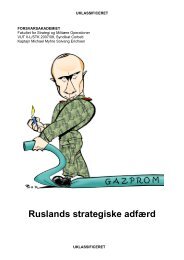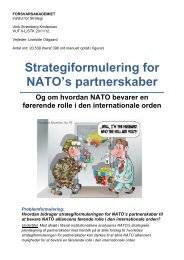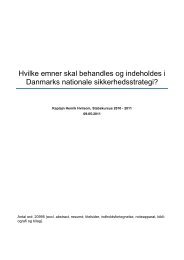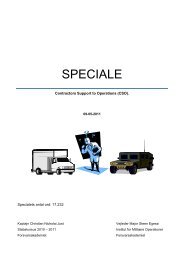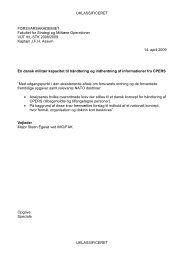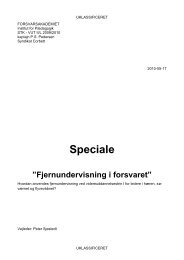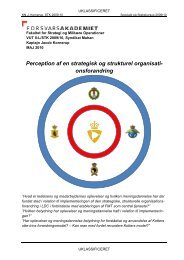Download PDF
Download PDF
Download PDF
Create successful ePaper yourself
Turn your PDF publications into a flip-book with our unique Google optimized e-Paper software.
BRIEFWhy Obama needs dronesUS Drone Policy during the Obama AdministrationBy Philip Chr. Ulrich, M.A. in American StudiesFORSVARSAKADEMIETS FORLAG
BRIEFWhy Obama needs dronesUS Drone Policy during the Obama AdministrationBy Philip Chr. Ulrich, M.A. in American Studies
The Royal Danish Defence College is the Danish armed forces’ powerhouse for education, training andresearch-generated consultancy. Our research is conducted within a broad range of military-related topics.Our research priorities, such as topics and resource allocation are determined by the Commandant of theRoyal Danish Defence College, who is aided by a research council.Research at the Royal Danish Defence College should enlighten and challenge the reader, whether they arein the armed forces or in the surrounding environment. This is only achievable if the employees have thefreedom to administer their own research projects and draw their own conclusions. This is a principle, whichis honoured at the Royal Danish Defence College.We hope you enjoy reading the Royal Danish Defence College’s publications!© Royal Danish Defence CollegeAll rights reserved. Mechanical, photographic or other reproduction or photocopying from this book or partsthereof is only allowed according to agreements between The Danish Defence and CopyDan.Any other use without written consent from the Royal Danish Defence College is illegal according to Danishlaw on intellectual property right. Excepted are short extracts for reviews in newspapers or the like.Copenhagen June 2013Royal Danish Defence CollegeRyvangs Allé 1DK-2100 CopenhagenDenmarkPhone: +45 3915 1515Fax: +45 3929 6172Editor: Director of the Institute for Strategy Ole KværnøLayout by B-O. KureISBN: 978-87-7147-029-1Royal Danish Defence College Publishing House
Royal Danish Defence CollegeIntroductionOn May 23 rd , 2013, President Obama held one of his most signifi cant nationalsecurity speeches at the National Defense University (NDU) in Washington D.C.The speech has been seen by many as the announcement of the end of the waron terror and the drawing down of the administration’s use of drones.However, from May 23 rd until June 9 th , 2013, the United States launched at least4 drone strikes in Yemen and Pakistan, killing, according to offi cial sources, 26militants. 1 How does the continued use of drones add up with President Obama’sspeech at the NDU? The fact is that the war on terror is not over yet, and thecontinued efforts against terror networks and their affi liates around the Middle Eastis a sign that drones will continue to play a major role in US security policy. Dronesprovide a cost-effi cient and effective tool to continue the war, while allowing theadministration to disengage and avoid major military operations in the war on terror.The subsequent surveillance scandals that have hit the Obama administration inMay and June 2013 further underline the fact that the war on terror is not over, itis just being fought less overtly than in the past.Based on President Obama’s speech and his administration’s defense budgetproposal presented in April 2013, this brief will analyze how there seems to be nomajor change on the horizon in the US use of drones. The Obama administrationneeds drones to continue pursuing its foreign policy objectives of continuouslyasserting US global presence as well as continuing the fi ght against al Qaeda. Andas President Obama stated in his speech at the NDU, “…our actions are effective.[…] Simply put, these strikes have saved lives.” 2Drones have primarily been used in three ways:- As tactical support for forces on the ground in Iraq and Afghanistan- As a counter-terrorism asset, fl ying missions in Afghanistan, Pakistan,Yemen, and Somalia- As an Intelligence, Surveillance, and Reconnaissance (ISR) asset(1) Bill Roggio: “US launches fi rst drone strike in Pakistan in 6 weeks”, 29 May 2013http://www.longwarjournal.org/archives/2013/05/us_launches_fi rst_dr.phpBill Roggio: “US drones kill 8 AQAP fi ghters in Yemen strike”, 1 June 2013http://www.longwarjournal.org/archives/2013/06/us_drones_kill_8_aqa.phpBill Roggio: “US drones kill 6 in North Waziristan”, 7 June 2013http://www.longwarjournal.org/archives/2013/06/us_drones_kill_6_in.phpBill Roggio: “US drones kill AQAP commander, 5 fi ghters in Northen Yemen”, 9 June 2013http://www.longwarjournal.org/archives/2013/06/us_drones_kill_aqap_1.php(2) Remarks by the President at the National Defense University, 23 May 2013http://www.whitehouse.gov/the-press-offi ce/2013/05/23/remarks-president-national-defenseuniversity3
The use of drones has enabled the Obama administration to support internationaloperations in Libya and Mali while limiting or even avoiding the commitment of “bootson the ground”. esides this, drones have been invaluable in allowing the Obamaadministration to continue the fi ght against al Qaeda, the Taliban, and their affi liates.So the Obama administration has no interest in drawing down on its reliance ondrones any time soon.Obama’s “Leading from Behind” DoctrineThe US economy is in historically bad shape, and millions of Americans are withoutjobs. For that reason, a primary objective for the Obama administration has beento focus on domestic nation building, or as it says in the administration’s strategicguidance from January 2012, “we must put our fi scal house in order here at homeand renew our long-term economic strength.” 3At the same time, the Obama administration has two recent wars to take into accountbefore judging the need for US commitment. Since President Obama took offi cein 2009, his administration has worked intensely on disengaging from Iraq andAfghanistan and on avoiding new, expensive, long-term engagements. The purposeof this has been to focus on domestic nation building in the United States, as wellas to put greater focus on the Asia-Pacifi c region, as announced in the strategicguidance of January 2012. 4Because the United States has wide-ranging global interests, it would be impossiblefor the United States to revert back to a 1930s isolationist foreign policy and solelyfocus on domestic issues. Therefore, the purpose of the 2012 strategic guidancewas to create a strategy that “preserves American global leadership, maintainsour military superiority” 5 while giving the Obama administration breathing spaceto focus on domestic policy.To that end, the Obama administration took steps to withdraw US forces from Iraq,which resulted in the fi nal US combat forces pulling out of Iraq in December 2011.Besides withdrawing forces from Iraq, one of the fi rst major foreign policy decisionsof the Obama administration was to add additional forces to Afghanistan in orderto facilitate a transition to indigenous Afghan security forces.As the situation in the Middle East evolved with great rapidity during the Arab Spring,the Obama administration was forced to act. However, as part of the pragmaticapproach to foreign policy that the Obama administration has displayed since it tookoffi ce in 2009, the US engagement has been characterized by the phrase “leading(3) Department of Defense: “Sustaining US Global Leadership: Priorities for 21st Century Defense”,(Washington D.C., January 2012), foreword(4) Philip Chr. Ulrich: “The US Pivot Towards Asia-Pacifi c: Third Time’s the Charm?” (Copenhagen,Royal Danish Defence College, February 2013)(5) Ibid: foreword4
Royal Danish Defence Collegefrom behind”. In Libya the United States assisted with assets not contained in theEuropean Allies’ arsenals, thus supporting air strikes through the use of Intelligence,Surveillance and Reconnaissance (ISR) assets such as drones. 6 The same approachcould be seen as France engaged in military operations in Mali to counter the risingdominance of Islamic militants. For the military operations in Mali, the United Statesonce again contributed with ISR assets to support French air operations. 7These more limited contributions to international operations are the result of theapproach that the Obama administration has consistently been forced to take onforeign policy issues due to domestic circumstances. Domestic policy has thus beenthe deciding factor in questions of international engagement during the Obamaadministration.Drones as central asset in war on terrorIn his speech on May 23rd, President Obama called for an end to the war on terrorthat the United States has been engaged since 2001. However, it was not anannouncement declaring an end to the war – rather it was an announcement ofthe beginning of the end: “Our systematic effort to dismantle terrorist organizationsmust continue. But this war must end. That’s what history advises. That’s what ourdemocracy demands.” 8 In sum, the speech was not a declaration of the end of thewar on terror, but an attempt to start the process of getting the United States outof the post-9/11 era and into a new chapter of history.The revelations of massive surveillance by the National Security Agency show themore covert way that the war on terror continues. The continued war on terror willbe based more on intelligence gathering, which could possibly lead to continued useof drone strikes. This will be the way that the United States can maintain pressureon terrorist organizations while moving away from the constant state of war thecountry has been in since September 11 th , 2001.Since 2009, drones have become a cornerstone of the Obama administration’scounter-terrorism policy. In 2009, then-CIA director Leon Panetta said that droneswere “... the only game in town in terms of confronting or trying to disrupt the alQaeda leadership.” 9 This has been the basic idea running through the Obamaadministration’s counter-terrorism policy since 2009.(6) Ivo H. Daalder and James G. Stavridis: “NATO’s Success in Libya”:http://www.nytimes.com/2011/10/31/opinion/31iht-eddaalder31.html?_r=0(7) Adam Entous, David Gauthier-Villars and Drew Hinshaw: “U.S. Boosts War Role in Africa”:http://online.wsj.com/article/SB10001424127887324539404578338590169579504.html(8) Remarks by the President at the National Defense University, 23 May 2013http://www.whitehouse.gov/the-press-offi ce/2013/05/23/remarks-president-national-defenseuniversity(9) Micah Zenko: “Reforming U.S. Drone Strike Policies” (Council on Foreign Relations, CouncilSpecial Report No. 65, January 2013), p. 95
The reliance on drones has gone so far that the budget proposal for fi scal year 2014states the following: “The MQ-1 Predators and MQ-9 Reapers have been, and willcontinue to be, our counterinsurgency and counter-terrorism workhorses.” 10And they have indeed been workhorses. Since 2008, the United States hasconducted approximately 330 drone strikes in Pakistan and 70 in Yemen, comparedto 10 and 1 respectively during the period 2002-2008. 11 These strikes have beensupplemented by strikes against targets in Somalia. The increasing dependencecan also be seen in the number of US drones. In September 2001, the UnitedStates had 50 drones. By April 2012, the number had risen to 7500 drones. Thesenumbers include drones of all sizes, ranging from drones used by infantry units onthe ground in Afghanistan for tactical reconnaissance to large drones such as thePredator, Reaper and Global Hawk systems. 12Due to the “success” of the drone policy, it does not seem like the Obamaadministration is going to change its reliance on drones. In his speech at the NationalDefense University in Washington D.C. on May 23 rd , 2013, President Obama praisedthe drone policy: “To begin with, our actions are effective. […] Dozens of highly skilledal Qaeda commanders, trainers, bomb makers and operatives have been taken offthe battlefi eld. Plots have been disrupted that would have targeted internationalaviation, U.S. transit systems, European cities and our troops in Afghanistan. Simplyput, these strikes have saved lives.” 13Overall, the speech was a defense of the Obama administration’s drone policy. Onepoint President Obama emphasized was that, when the drone policy is criticized, thecritics should weigh the alternative of doing nothing: “But as Commander-in-Chief,I must weigh these heartbreaking tragedies [civilian casualties in drone strikes]against the alternatives. To do nothing in the face of terrorist networks would invitefar more civilian casualties – not just in our cities and our facilities abroad, but alsoin the very places like Sana’a and Kabul and Mogadishu where terrorists seek afoothold.” 14As has already been mentioned, the drone policy also strikes a chord in the foreignpolicy of the Obama administration. Using drones allows the United States to avoid(10) Department of Defense: “Defense Budget Priorities and Choices. Fiscal Year 2014”(Washington D.C., April 2013), p. 30(11) Bill Roggio and Alexander Mayer: Charting the data for US airstrikes in Pakistan, 2004 – 2013http://www.longwarjournal.org/pakistan-strikes.php (updated on 7 June 2013)Bill Roggio and Bob Barry: Charting the data for US air strikes in Yemen, 2002 – 2013http://www.longwarjournal.org/multimedia/Yemen/code/Yemen-strike.php (Updated on 9 June2013)(12) Micah Zenko: “Reforming U.S. Drone Strike Policies” (Council on Foreign Relations, CouncilSpecial Report No. 65, January 2013), p. 3(13) Remarks by the President at the National Defense University:http://www.whitehouse.gov/the-press-offi ce/2013/05/23/remarks-president-national-defenseuniversity(14) Ibid.6
Royal Danish Defence Collegeengaging “boots on the ground” while still achieving its anti-terrorism objectives.In order to emphasize his point, President Obama evoked the memories of pastfailures in order to justify the use of drones: “It is false to assert that puttingboots on the ground is less likely to result in civilian deaths or less likely to createenemies in the Muslim world. The results would be more U.S. deaths, more BlackHawks down [italics added], more confrontations with local populations, and aninevitable mission creep in support of such raids that could easily escalate intonew wars.” 15 The mention of “Black Hawks down” evoked the memory of the failedUS engagement in Somalia in the early 1990s, and later in the speech, he evokedthe memory of Vietnam as well as the recent memories of Iraq and Afghanistan tofurther emphasize his point.Because of the risks involved in having “boots on the ground”, the necessityof continuing the war against al Qaeda, the successes of the drone policy, theinternational pressure to engage in the Arab Spring, and the recent experiences ofthe United States in foreign relations, drones have proven to be an important tool forthe Obama administration to achieve its foreign policy objectives with minimum risk.Issues with the use of dronesLegal issues rather than military ones have been a major problem for the Obamaadministration’s drone policy.Internationally, the United States has been criticized for targeting people withoutconsideration for national sovereignty and for violating humanitarian law. Withinthe United States, the issues have been focused around the transparency of thedecision-making process as well as constitutional issues regarding the targetingof American citizens.Generally speaking, the US public is very supportive of the Obama administration’sdrone policy. According to a Gallup poll from March 2013, 65% of the US populationsupported the administration’s use of drones to “Launch airstrikes in other countriesagainst suspected terrorists”. 16Therefore, the great debate in the United States has focused on the drone policy’slack of transparency. It was not until early 2012 that the Obama administrationacknowledged some of the strikes that had been carried out, and it was not untilMay 2013 that the administration admitted the killing of 4 US citizens, despite thefact that the most prominent of the operations, the targeting of Anwar al-Awlaki,took place in 2011.President Obama’s speech on May 23 rd , 2013 was also meant to counter thesecriticisms of his administration’s drone policy.(15) Ibid.(16) Alyssa Brown and Frank Newport: In U.S., 65% Support Drone Attacks on Terrorists Abroadhttp://www.gallup.com/poll/161474/support-drone-attacks-terrorists-abroad.aspx7
The speech specifi ed that the use of drones is legal according to both internationaland domestic US law. President Obama said that, because the United States wasattacked on September 11 th , 2001 by al Qaeda, the country is in a legitimate warwith “…al Qaeda, the Taliban, and their associate forces.” 17 This fact, accordingto President Obama, legitimizes the use of forces against these actors, no matterwhere they are found by the United States.Addressing the question of domestic legal issues, President Obama asserted thatany US citizen who goes abroad to plot attacks on the United States cannot beprotected by their citizenship. The domestic US legal foundation on which the Obamaadministration bases its policy is the “Authorization for the Use of Military Force”(AUMF) passed in Congress on September 18 th , 2001 as a response to the terroristattacks of September 11 th . According to the AUMF, “the President is authorizedto use all necessary and appropriate force against those nations, organizations,or persons he determines planned, authorized, committed, or aided the terroristattacks that occurred on September 11, 2001, or harbored such organizations orpersons, in order to prevent any future acts of international terrorism against theUnited States by such nations, organizations or persons.” 18However, as part of the effort to ensure more transparency, President Obamaannounced a proposal to repeal the AUMF and to formulate new decisionmaking procedures for conducting drone strikes. This effort can be seen bothas a consequence of the massive public criticism of the transparency issue andas an attempt to improve the Obama administration’s image, which has beenhammered by a number of scandals. The scandals revolve around the terroristattack on the US consulate in Benghazi on September 11 th , 2012, the targeting ofconservative political movements by the Internal Revenue Service (IRS), and thesecret surveillance of an Associated Press reporter by the Justice Department. Inthe face of these scandals combined with the lingering criticism of its drone policy,the Obama administration was in need of improving its image. President Obama’sspeech on May 23 rd , 2013 should also be seen in this light.Drones in Anti-Access/Area Denial EnvironmentsA central part of the 2012 strategic guidance was the development of capabilities tooperate in a so-called “A2/AD environment”. Because of the increasing capabilitiesof potential adversary states to deny the United States access to strategicallyimportant regions, it has become a central issue for the Department of Defenseto develop capacities to enable continued operations despite enemy actions. Thestrategic guidance states the following: “Accordingly, the U.S: military will invest as(17) Remarks by the President at the National Defense University:http://www.whitehouse.gov/the-press-offi ce/2013/05/23/remarks-president-national-defenseuniversity(18) United States Congress: “Public Law 107-40” (Washington D.C., 107 th Congress, 18 September2001), section 2a8
Royal Danish Defence Collegerequired to ensure its ability to operate effectively in anti-access and area denial(A2/AD) environments.” 19The purpose of operating despite enemy A2/AD capacities is explained in theDepartment of Defense’s Joint Operational Access Concept:Projecting U.S. military force invariably requires extensive use ofinternational waters, international airspace, non-sovereign cyberspace,space, and the electromagnetic spectrum. U.S. access to and freedomof navigation within these global commons are vital to its internationalinterests, both because the American way of life requires free accessto the global marketplace and as a means for projecting military forceinto hostile territory.” 20Drones represent a key aspect of the strategic and doctrinal thinking of the USmilitary. For the purpose of operating in an A2/AD environment, drones are ideal.On May 13 th , 2013, the US Navy carried out the fi rst ever launch of a drone from anaircraft carrier, the USS George H. W. Bush. The Northrop Grumman X-47B, or anyother similar system, can provide an increased action radius for US aircraft carriers,thus better enabling them to operate in an A2/AD environment.The new X-47B drone has an unrefueled combat radius of nearly 3000 km, which istwice that of an F-35 Joint Strike Fighter. This range can be doubled by air refueling,which also means that the X-47B can stay in the air for anywhere between 50 and100 hours. Its internal payload capacity is equivalent to that of the F-35 Joint StrikeFighter. 21 All these features, combined with a stealth design, make the X-47 B andequivalent systems ideal for achieving the goal set by the Joint Operational AccessConcept, which is to allow US forces to “achieve operational access in the face ofarmed opposition by a variety of potential enemies and under a variety of conditions,as part of a broader national approach.” 22The Department of Defense’s appreciation of the potential of these drone systemscan also be seen in the budget proposal for fi scal year 2014, which was presentedby the Department of Defense in April 2013. Part of the proposal requests fundsfor the further development of sea-based drone capacities, which would amount to$427 million, as part of an overall $2.5 billion program to invest in such airborne(19) Department of Defense: “Sustaining U.S. Global Leadership: Priorities for 21 st CenturyDefense”, (Washington D.C., January 2012), pp. 4-5(20) Department of Defense: “Joint Operational Access Concept” (Washington D.C., January2012), p. 5(21) Thomas P. Ehrhard and Robert O. Work: “The Unmanned Combat Air System CarrierDemonstration Program: A New Dawn For Naval Aviation?” (Washington D.C., Center for Strategicand Budgetary Assessments, May 2007), p. 32(22) Department of Defense: “Joint Operational Access Concept (JOAC)” (Washington D.C., 17January 2012), p. 19
ISR capacities. 23 The goal for the Department of Defense is to “enhance missioneffectiveness, improve operational speed and effi ciency, and affordably close warfighting gaps.” 24The plan is to fl y drones from US aircraft carriers in 2019. 25Drones will remain centralThe use of drones has worked well for the Obama administration -- both the useof armed and unarmed ISR drones for international missions in Libya and Mali aswell as the use of drones for targeting al Qaeda, Taliban and affi liate organizations.Although many viewed it as an announcement of the end of the war on terror,President Obama’s speech on May 23 rd , 2013 was meant as a defense of thedrone policy and a justifi cation for the continued use of drones in counter-terrorismoperations. The successes that the programs have achieved are remarkable, leadingto a diminished threat from al Qaeda and affi liate organizations against the UnitedStates mainland.The Obama administration’s foreign policy since 2009 has been focused ondisengaging from the Middle East, rebalancing (or pivoting) to the Asia-Pacifi c region,and focusing on domestic nation building in the United States. The use of droneshas allowed the Obama administration to pursue such a policy while still engagingto secure US interests. The economic and political conditions in the United Stateswill not change any time soon to a point where a more active US foreign policy canreturn, and even then, the primary focus will still be on countering Chinese infl uencein the Asia-Pacifi c region. Drones will therefore continue to be a primary counterterrorismasset for the Obama administration, as well as an asset with which theUnited States can contribute to international operations, thus contributing capacitiesthe European Allies lack.At the same time, drones have great potential in relation to the increasing focus anddevelopment of capacities that will enable the United States to operate in an A2/AD environment. This priority is emphasized in both the 2012 strategic guidanceas well as the Joint Operational Access Concept, and subsequently in the budgetproposal for fi scal year 2014.(23) Secretary of Defense Chuck Hagel’s Submitted Statement to the House Armed ServicesCommittee on the FY 2014 Budget Request for the Department of Defense, Thursday, 11 April 2013:http://armedservices.house.gov/index.cfm/hearings-display?ContentRecord_id=c5db7299-6f1a-4c19-818f-0aeaffda938a&ContentType_id=14f995b9-dfa5-407a-9d35-56cc7152a7ed&Group_id=64562e79-731a-4ac6-aab0-7bd8d1b7e890&MonthDisplay=4&YearDisplay=2013(24) Department of Defense: “Unmanned Systems Integrated Roadmap. FY2011-2036”,(Washington D.C.), p. 5(25) David Axe: “The case for sea-based drones”http://blogs.reuters.com/great-debate/2013/05/14/the-case-for-sea-based-drones/10
Royal Danish Defence CollegeAll these factors indicate that drones will continue to be a central part of US defensepolicy, both in a counter-terrorism capacity and in future force developments forcounter A2/AD operations.11



